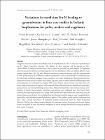| dc.contributor.author | COXON, CATHERINE ELIZABETH | |
| dc.date.accessioned | 2013-09-12T11:14:58Z | |
| dc.date.available | 2013-09-12T11:14:58Z | |
| dc.date.issued | 2009 | |
| dc.date.submitted | 2009 | en |
| dc.identifier.citation | Fenton, O., Coxon, C., Haria, A., Horan, B., Humphreys, J., Johnston, P., Murphy, P., Necpalova, M., Premrov, A. & Richards, K.G., Variations in travel time for N loading to groundwaters in four case studies in Ireland: Implications for policy makers and regulators, Tearmann: Irish Journal of Agri-environmental Research, 7, 2009, 129 - 142 | en |
| dc.identifier.other | Y | |
| dc.identifier.uri | http://hdl.handle.net/2262/67393 | |
| dc.description | PUBLISHED | en |
| dc.description.abstract | Mitigation measures to protect waterbodies must be implemented by 2012 to meet the requirements of the EU Water Framework Directive. The efficacy of these measures will be assessed in 2015. Whilst diffuse N pathways between source and receptor are generally long and complex, EU legislation
does not account for differences in hydrological travel time distributions that may result in different water quality response times. The ?lag time? between introducing mitigation measures and first improvements in water quality is likely to be different in different catchments; a process that should be considered by policy
makers and catchment managers. Many examples of travel time variations have been quoted in the literature but no Irish specific examples are available. Lag times based on initial nutrient breakthrough at four
contrasting sites were estimated to a receptor 500 m away from a source. Vertical travel times were estimated using a combination of depth of infiltration calculations based on effective rainfall and subsoil physical parameters and existing hydrological tracer data. Horizontal travel times were estimated using a combination
of Darcian linear velocity calculations and existing tracer migration data. Total travel times,assuming no biogeochemical processes, ranged from months to decades between the contrasting sites; the shortest times occurred under thin soil/subsoil on karst limestone and the longest times through thick low permeability soils/subsoils over poorly productive aquifers. Policy makers should consider hydrological lag
times when assessing the efficacy of mitigation measures introduced under the Water Framework Directive. This lag time reflects complete flushing of a particular nutrient from source to receptor. Further
research is required to assess the potential mitigation of nitrate through denitrification along the pathway from source to receptor. | en |
| dc.description.sponsorship | Teagasc Walsh Fellowship | en |
| dc.format.extent | 129 | en |
| dc.format.extent | 142 | en |
| dc.language.iso | en | en |
| dc.relation.ispartofseries | Tearmann: Irish Journal of Agri-environmental Research; | |
| dc.relation.ispartofseries | 7; | |
| dc.rights | Y | en |
| dc.subject | groundwater nitrogen | en |
| dc.subject | groundwater travel time | en |
| dc.title | Variations in travel time for N loading to groundwaters in four case studies in Ireland: Implications for policy makers and regulators | en |
| dc.type | Journal Article | en |
| dc.type.supercollection | scholarly_publications | en |
| dc.type.supercollection | refereed_publications | en |
| dc.identifier.peoplefinderurl | http://people.tcd.ie/cecoxon | |
| dc.identifier.rssinternalid | 68757 | |
| dc.rights.ecaccessrights | OpenAccess | |




